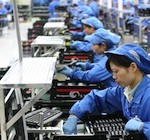At first glance, it’s bad. Superstar China’s growth target is lowered to 7.5% for the year, down from 8% previously, but shockingly lower than the blistering 10% average growth China racked up over the last two decades.
Across the water, India is slowing to 6%, well below the mandatory 7% needed just to create jobs in the formal and informal economy for over 20 million new workers each year. This must be bad news for India, China and the world.
But the two situations couldn’t be more different. India’s slowdown is the result of lack of economic reform, derelict infrastructure, archaic laws and asphyxiating graft. Slowing to 6% is indeed a dire outcome for India. The country’s baby boomers are now in the population bulge – over 50% of the people. And they need livelihoods.
China’s lower growth is a managed target, set expressly by the Beijing leadership to cool the economy from rising inflation, deflate a real estate bubble and most importantly direct growth to China’s home economy rather than primarily drive growth through exports. In other words, after three decades of automatic, on-time development as a producer for the world, China’s taking a breather because it can afford to take a slowdown. This pause also fits the times.
But a political backlash is growing against China in the United States and Europe as a jobs vulture. It’s a little late to blame China but it pays politically. In response, China is unfurling a banner that says “Rebalancing” of its home economy. That may reduce protectionist calls from the U.S. and take the pressure off China to revalue the yuan, now about 6.3 to the dollar. The rebalancing mantra also recognizes that China’s largest markets, Europe and the U.S., may be on the slow growth track for some years ahead.
Internally, China is accepting slower growth for its own interest. China now has to position itself to move from the factory China is, to the service and value-added China that its leadership has prescribed in its last two five-year plans. So far, however, that transformation has not taken place. China has not shown an ability to reorient its economy in that new direction.
Beijing recognizes the end of an era. For the last 30 years, China has been leveraging its “population dividend” – the economic principle that allowed it to transform millions of villagers into cheap labor for its export factories. While China can haul out willing workers from its Western states by building new highways and power plants, most economists believe its cheap-labor-days are over.
Just as well. China will have fewer jobs to fill than the 10 million it needed to create annually in the past. The average age of a Chinese worker is 37 and it is expected that some 50 million workers will start leaving the work force in five years, gradually turning China into the world’s largest aging society. China will need to increase social welfare spending and keep raising the minimum wage, which will put more money in the pockets of Chinese consumers. The benefit from this should be a bigger consumer market.
Contrast that with India, where the average worker’s age is 23 and some 600 million are under 30. India inherits the population dividend but only if it can create useful jobs for new young workers. To do that it needs to ramp up growth in the 8% to 9% range. That is doable, argues Delhi economist Surjit Bhalla, who thinks India can cruise along at 9% while still keeping inflation in check. Inflation in January was 5.99%, but the long-term rate has averaged nearly 8%, a huge burden when it hits basic fuel and food for the poor.
So the India-China slowing-growth story isn’t about trading places. But it does suggest the time for India to act is now. India has no capacity to become a factory export machine; nor does it necessarily have to. Its domestic economy is so large and underserved, there’s plenty to go around at home alone. Just 15% of India is manufacturing; and as a democracy it has a mandate to provide social and economic upliftment for all its people.
But the old adage about China having to peddle its bicycle at 8% or fall off the growth tables now applies to India. The country can’t afford to slack off, and massive government spending can’t keep the bike upright. India has to clear the acres of regulatory brush and tax traps off its path. China with $3.8 trillion of cash reserves on its books can take a break, sit back like a fat cat banker and watch the show.
Bob Dowling is an Editorial Advisor to Gateway House: Indian Council on Global Relations, and Manjeet Kripalani is Executive Director of Gateway House.
This article was exclusively written for Gateway House: Indian Council on Global Relations. You can read more exclusive content here.
For interview requests with the author, or for permission to republish, please contact outreach@gatewayhouse.in.
© Copyright 2012 Gateway House: Indian Council on Global Relations. All rights reserved. Any unauthorized copying or reproduction is strictly prohibited.


